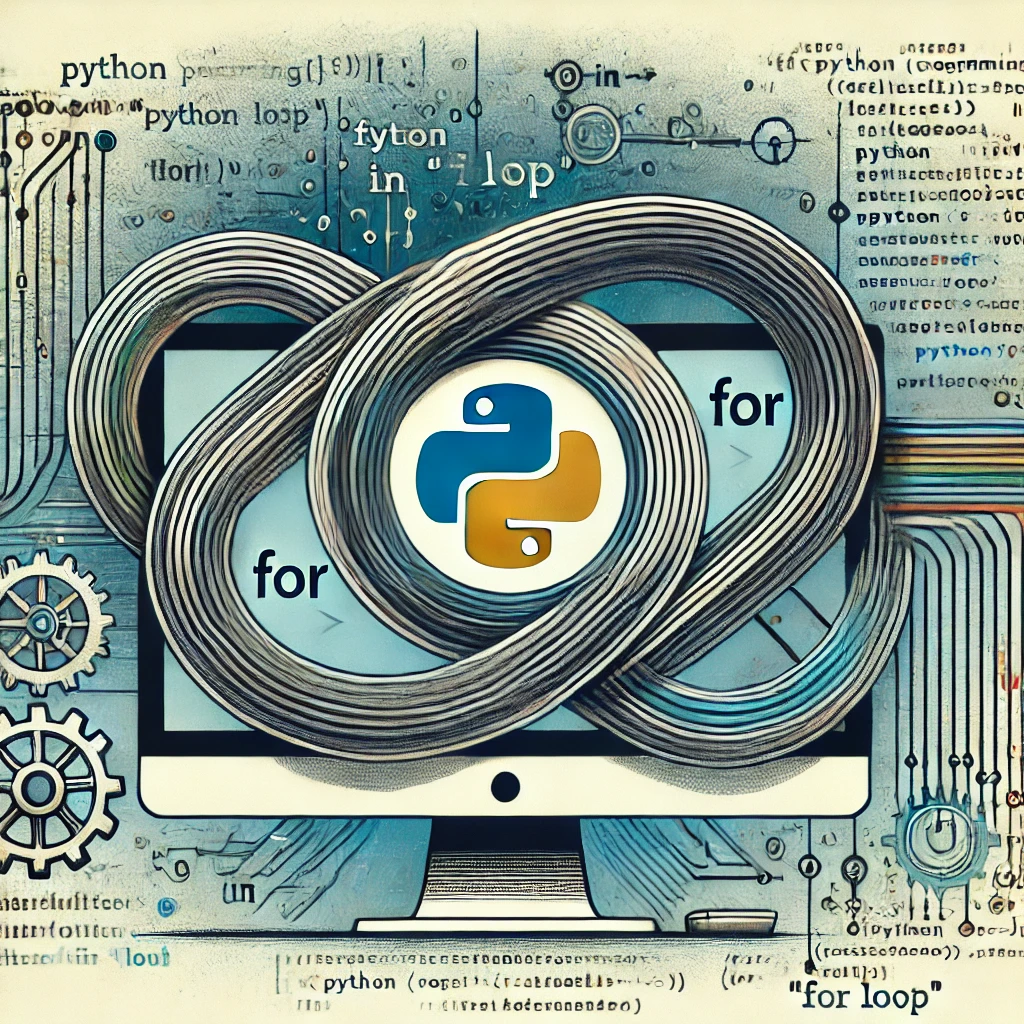Python, a powerful and versatile programming language, has several key features that make coding easier and more efficient. One of these fundamental features is the ‘for loop’. Whether you’re just starting with Python or are an experienced developer looking to enhance your knowledge, mastering the use of loops is essential. In this guide, we’ll dive deep into Python’s ‘for loop,’ explaining its syntax, functionality, and practical applications.
Table of Contents
- What is a For Loop?
- Syntax of a Python For Loop
- How the Python For Loop Works
- Looping Through a List in Python
- Using For Loop with Strings
- Iterating Over a Range of Numbers
- For Loops with Nested Loops
- For Loops and the
breakStatement - Using the
continueStatement in a For Loop - Else Clause in a For Loop
- Common Mistakes and How to Avoid Them
- Applications of For Loop in Python
- Optimizing For Loops for Performance
- For Loop vs. While Loop in Python
- Conclusion: The Power of Python’s For Loop
1. What is a For Loop?
A ‘for loop’ is a control flow statement used to repeatedly execute a block of code a set number of times or while iterating over a collection of items. In Python, this loop allows programmers to execute a block of code for each element in a sequence (like a list, tuple, dictionary, or string) without manually managing loop counters.
The simplicity of Python’s ‘for loop’ distinguishes it from languages like C or Java, where counters are used to control iteration. In Python, the ‘for loop’ iterates over iterable objects directly, eliminating the need for manual index management.
2. Syntax of a Python For Loop
The syntax of the ‘for loop’ in Python is both intuitive and flexible. Here’s the basic structure:
for item in iterable:
# Block of code- for: This is the keyword that initiates the loop.
- item: This variable holds the current element in the iterable.
- iterable: This can be any sequence or collection, such as lists, tuples, dictionaries, or strings.
Example of a basic ‘for loop’:
fruits = ['apple', 'banana', 'cherry']
for fruit in fruits:
print(fruit)This loop prints each fruit in the list one by one.
3. How the Python For Loop Works
In Python, a ‘for loop’ works by fetching elements from an iterable one by one. It assigns the current element to the loop variable and executes the code block for each item.
Here’s a step-by-step breakdown:
- Python retrieves the first item from the iterable.
- It assigns the item to the loop variable (e.g.,
fruitin the previous example). - The block of code under the loop is executed.
- The next item is fetched and the process repeats until the iterable is exhausted.
This automation makes Python’s ‘for loop’ both convenient and less error-prone compared to manually iterating over indexes.
4. Looping Through a List in Python
Lists are one of the most common data structures in Python, and looping through them using a ‘for loop’ is incredibly straightforward.
Example:
numbers = [1, 2, 3, 4, 5]
for number in numbers:
print(number)This loop prints each number in the list, allowing you to access individual elements in the sequence.
Additionally, if you need the index of each element, Python provides the enumerate() function:
for index, number in enumerate(numbers):
print(f"Index: {index}, Number: {number}")5. Using For Loop with Strings
Strings in Python are essentially sequences of characters, meaning you can easily loop through them just like lists.
Example:
message = "Hello, World!"
for character in message:
print(character)Each character of the string is printed on a new line. This is useful when you need to analyze or manipulate individual characters in a string.
6. Iterating Over a Range of Numbers
Python provides a built-in range() function to generate a sequence of numbers, which is often used in ‘for loops’ to iterate over a specific range.
Example:
for i in range(5):
print(i)This loop prints numbers from 0 to 4 (as the range(5) generates numbers from 0 up to, but not including, 5).
You can also specify a start value and a step:
for i in range(2, 10, 2):
print(i)This loop prints 2, 4, 6, 8, as it starts from 2, increments by 2, and stops before reaching 10.
7. For Loops with Nested Loops
A nested ‘for loop’ occurs when one ‘for loop’ is placed inside another. This is useful for iterating through multiple dimensions, like a list of lists.
Example:
matrix = [
[1, 2, 3],
[4, 5, 6],
[7, 8, 9]
]
for row in matrix:
for element in row:
print(element)This prints each element in the 2D list, going row by row.
8. For Loops and the break Statement
Sometimes, you may want to exit a loop early. The break statement allows you to terminate the loop before it has gone through all the elements.
Example:
numbers = [1, 2, 3, 4, 5]
for number in numbers:
if number == 3:
break
print(number)This loop prints 1 and 2, then exits when it encounters 3, effectively “breaking” out of the loop.
9. Using the continue Statement in a For Loop
The continue statement, on the other hand, skips the current iteration and moves to the next.
Example:
for i in range(5):
if i == 2:
continue
print(i)This loop prints 0, 1, 3, 4, skipping the iteration where i equals 2.
10. Else Clause in a For Loop
Interestingly, Python allows the use of an else clause with ‘for loops’. The else block executes after the loop finishes, provided that the loop wasn’t terminated by a break.
Example:
for i in range(5):
print(i)
else:
print("Loop completed!")This prints 0 through 4, followed by “Loop completed!”
However, if a break occurs, the else clause will not be executed.
11. Common Mistakes and How to Avoid Them
While Python’s ‘for loop’ is relatively simple, common mistakes can still occur:
- Modifying a list while iterating: Changing the list during iteration can cause unexpected behavior. Use list slicing or a copy instead.
- Using the wrong iterable: Make sure the object you are looping over is iterable (like a list or string).
12. Applications of For Loop in Python
Python’s ‘for loop’ is versatile and used in various scenarios:
- Data analysis: Iterating through datasets to extract, filter, or transform data.
- File handling: Reading lines from a file or processing multiple files.
- Automation: Running repetitive tasks, such as generating reports or processing images.
13. Optimizing For Loops for Performance
When working with large datasets or performance-sensitive applications, it’s essential to optimize your loops:
- Use list comprehensions: They are often faster than traditional ‘for loops’ for creating lists.
- Avoid deep nesting: Excessive nesting can slow down your code. Refactor to keep the loop structure simple.
14. For Loop vs. While Loop in Python
While ‘for loops’ iterate over a sequence of elements, ‘while loops’ continue as long as a condition is true. Use ‘for loops’ when the number of iterations is known and ‘while loops’ for indefinite loops that depend on a condition.
15. Conclusion: The Power of Python’s For Loop
Python’s ‘for loop’ is a fundamental tool that brings both power and simplicity to programming. Its flexibility, combined with the ability to iterate over any iterable object, makes it an indispensable part of Python programming. Whether you’re processing lists, handling files, or automating tasks, mastering the ‘for loop’ will significantly enhance your coding efficiency.


Leave a Reply